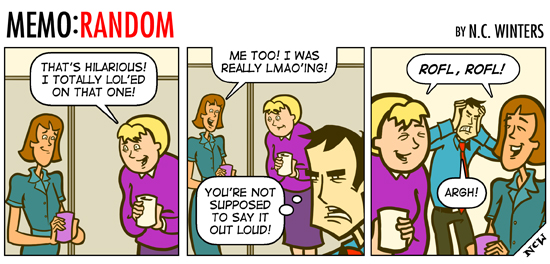
Ever since human beings succumbed to the limitless world of the Internet, “chatting” has been one of the most popular activities for people of all ages. Right from the early days of IRC or Internet Relay Chat (created by Jarkko Oikarinen in 1988) to the modern day marvels in the form of Skype and Google Talk and Yahoo Messenger, “chatting” has captured and continues to capture the imagination of millions of people all around the world. While this made the world several times smaller at the speed of light, it also gave birth to a whole new language that went beyond boundaries of geography or demography. “Chat Lingo” suddenly transformed the way people would communicate with others. Things like “a/s/l”, “lmao”, “lol”, “brb”, “rofl” and countless such seemingly meaningless acronyms made their way into day-to-day conversations, emails and even documents. Real world emotions were quickly replaced by online “emoticons” where a mind-boggling range of feelings were expressed using an equally mind-boggling combination of letters and symbols on the computer keyboard!
Needless to say, as the Internet permeated into the world of business, it did not take much time for this new “lingo” to also make its way into business communication. Acronyms and smilies started appearing in formal business emails and corporate communications. While some would say that “PFA” and “FYI” and “IMHO” are time-efficient replacements for their expanded versions and contribute to increased productivity in the workplace, maybe it’s also fair to ask the question, have we taken things a bit too far? Have things come to such a state that people are beginning to ignore, intentionally or unintentionally, the basic etiquettes of formal business communication? Or, on the other hand, are we witnessing a startling evolution of communication protocols?
So, do we need to make a clear choice between age old traditions and modern day concoctions? Or is there space for both to co-exist in relative harmony? Well, I would say that both CAN and SHOULD co-exist as long as we have a clear understanding of what to use in a particular situation or circumstance. In most cases, the choice is quite simple, but where the lines of formality and informality are not as clear, we must make the choice carefully. In any form of communication, language is just a tool. How we use this tool determines the effectiveness and impact of whatever message we intend to convey. When in doubt, use caution and stay away from “chat lingo”. A well written email using the proper format of the language will definitely be taken more seriously than one which is riddled with a childish mix of short forms and smilies. What we write and how we write it conveys to others impressions about our personality, our thought process and our maturity. At the workplace, a friendly interaction with a colleague can surely ignore the rules of formal communication, but the same cannot be true for the email that you need to send to your CEO.
In conclusion, it is my view that modern communication has truly evolved and become far more flexible than how things used to be in the older times. Having said that, in the corporate world, care should be taken so as to not create a situation where the seriousness or gravity of an interaction is trivialised by the reckless use of “chat lingo”.
[quote]”Regardless of the changes in technology, the market for well-crafted messages will always have an audience.” – Steve Burnett[/quote]
